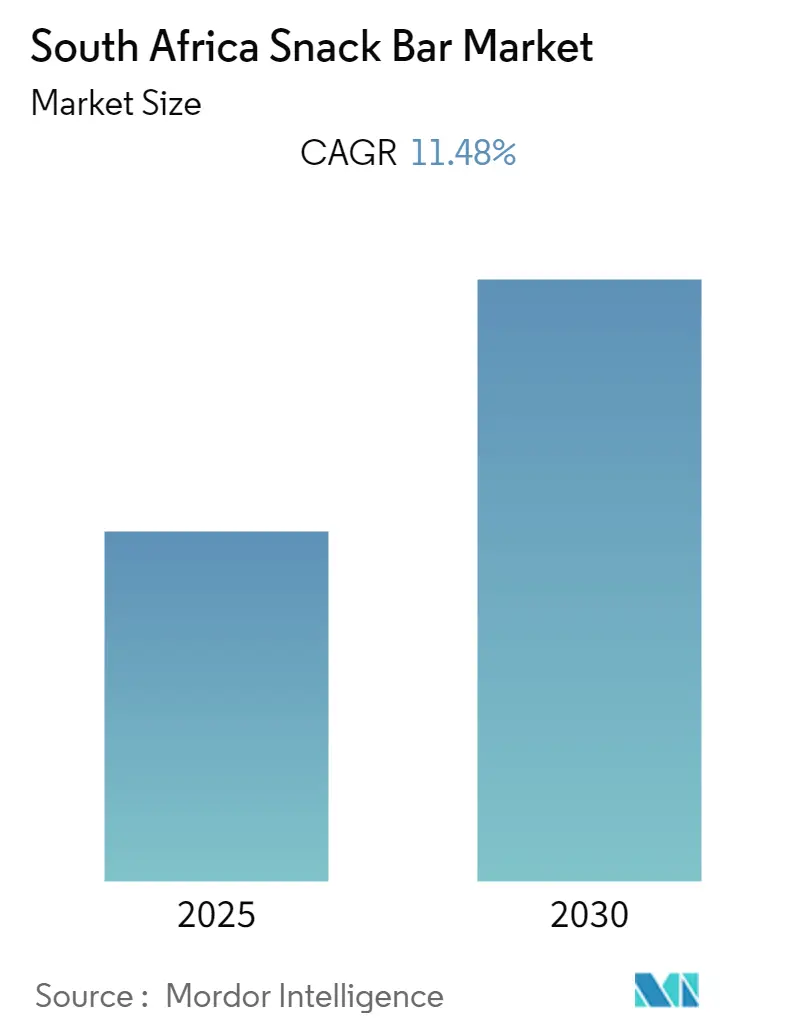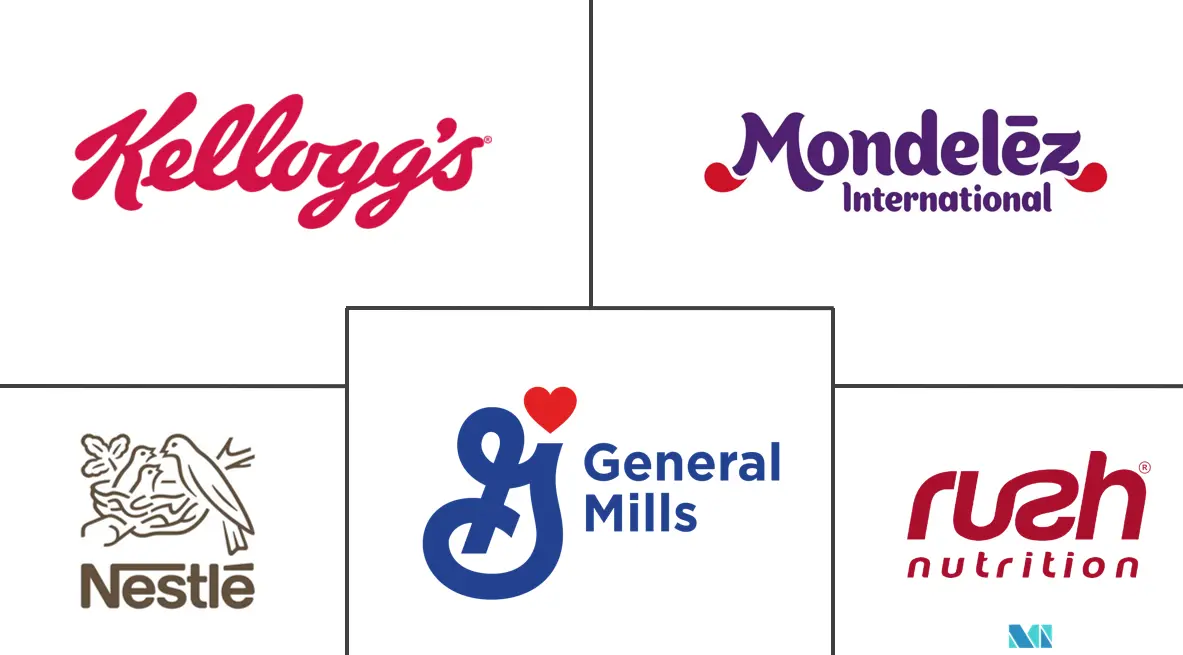
| Study Period | 2019 - 2030 |
| Base Year For Estimation | 2024 |
| Forecast Data Period | 2025 - 2030 |
| Historical Data Period | 2019 - 2023 |
| CAGR | 11.48 % |
| Market Concentration | Low |
Major Players
*Disclaimer: Major Players sorted in no particular order |
South Africa Snack Bar Market Analysis
The South Africa Snack Bar Market is expected to register a CAGR of 11.48% during the forecast period.
The demand for sports and energy bars is increasing in the country, especially among health-conscious consumers. Protein and fiber are the two most popular ingredients that are generating demand among consumers. This trend continues to influence manufacturers of energy bars, pushing them to launch high protein and high fiber bars that can serve as a supplementary source of energy and a meal replacement option.
Consequently, FutureLife, a brand leader in the South African functional food market, extended its current SmartFood product range by offering three energy and protein bars, namely, High Energy SmartBars, High Protein SmartBars, and High Protein Lite SmartBars, for South African consumers. The high-energy protein and sports bars are available across channels in the country, which the company claims are all non-GMO, contain added vitamins, minerals, and the daily immune supplement, MODUCARE.
The concept of allergen-free products is likely to stir the market for snack bars during the forecast period, providing access to worry-free snacking for people allergic to gluten, soy, or any other similar ingredient. Thus, manufacturers are also launching innovative products to cater to the potential market. However, a major factor that restrains the growth of the snack bars market is the number of options available in healthy snacks other than snack bars like nuts, seeds, and dried fruit products that are natural and readily available in the market.
South Africa Snack Bar Industry Segmentation
Snack bars are snack foods containing cereals, fruits, nuts, and flavor ingredients intended to supply quick energy and protein. The South African snack bar market is segmented by product type and distribution channel. On the basis of product type, the market is segmented into cereal bars, energy bars, and other snack bars. By distribution channel, the market is segmented into supermarkets/hypermarkets, convenience stores, specialty stores, online retail stores, and other distribution channels. For each segment, the market sizing and forecasts have been done based on value (in USD Million).
| Cereal Bars |
| Energy Bars |
| Other Snack Bars |
| Supermarkets/Hypermarkets |
| Convenience Stores |
| Online Retail Stores |
| Other Distribution Channels |
South Africa Snack Bar Market Size Summary
The South Africa snack bar market is experiencing significant growth, driven by an increasing demand for sports and energy bars among health-conscious consumers. This trend is largely influenced by the popularity of protein and fiber-rich ingredients, prompting manufacturers to introduce high-protein and high-fiber bars as energy supplements and meal replacements. Brands like FutureLife are expanding their product ranges to include various energy and protein bars, which are widely available across the country. The market is also seeing a rise in allergen-free products, catering to consumers with dietary restrictions. However, the availability of alternative healthy snacks, such as nuts and dried fruits, poses a challenge to the growth of snack bars. The demand for convenience foods is on the rise, fueled by changing social and economic patterns, increased awareness of healthy eating, and the desire for new taste experiences. Snack bars are becoming a popular choice for on-the-go snacking, particularly among busy professionals, teenagers, and individuals with hectic lifestyles, due to their easy consumption and portable packaging.
The distribution of snack bars is predominantly through supermarkets and hypermarkets, which hold a significant market share in the region. These retail channels, including major players like Shoprite, Pick n Pay, Spar, and Woolworths, are enhancing the shopping experience by strategically placing snack bars to encourage impulsive purchases. The market is highly competitive and fragmented, with both global and regional players such as The Kellogg Company, Mondelez International Inc., General Mills Inc., Nestle SA, and Rush Nutrition Inc. leading the charge. Companies are focusing on new product development to align with consumer trends and preferences, particularly in terms of health-promoting ingredients and innovative flavors. The proximity of supermarkets in urban areas further influences consumer snacking habits, making them a key distribution channel for snack bars.
South Africa Snack Bar Market Size - Table of Contents
1. MARKET DYNAMICS
- 1.1 Market Drivers
- 1.2 Market Restraints
-
1.3 Porter's Five Forces Analysis
- 1.3.1 Threat of New Entrants
- 1.3.2 Bargaining Power of Buyers/Consumers
- 1.3.3 Bargaining Power of Suppliers
- 1.3.4 Threat of Substitute Products
- 1.3.5 Intensity of Competitive Rivalry
2. MARKET SEGMENTATION
-
2.1 Product Type
- 2.1.1 Cereal Bars
- 2.1.2 Energy Bars
- 2.1.3 Other Snack Bars
-
2.2 Distribution Channel
- 2.2.1 Supermarkets/Hypermarkets
- 2.2.2 Convenience Stores
- 2.2.3 Online Retail Stores
- 2.2.4 Other Distribution Channels
South Africa Snack Bar Market Research FAQs
What is the current South Africa Snack Bar Market size?
The South Africa Snack Bar Market is projected to register a CAGR of 11.48% during the forecast period (2025-2030)
Who are the key players in South Africa Snack Bar Market?
Nestle SA, The Kellogg Company, General Mills Inc., Mondelez International Inc. and Rush Nutritional SA are the major companies operating in the South Africa Snack Bar Market.


